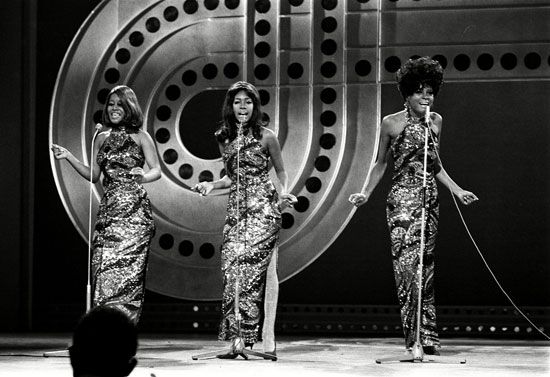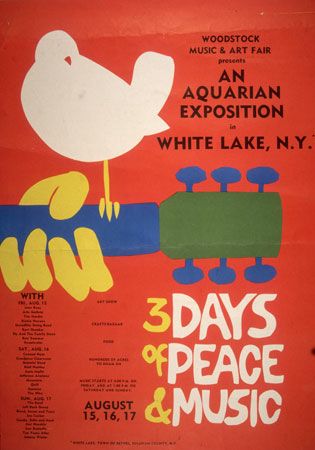Authenticity and commercialism
Our editors will review what you’ve submitted and determine whether to revise the article.
- Also called:
- rock and roll, rock & roll, or rock ’n’ roll
- Key People:
- Rob Zombie
- Lenny Kravitz
- Mark Knopfler
- Richard Perry
- Michael Bolton
Madonna can be described as a rock star (and not just a disco performer or teen idol) because she articulated rock culture’s defining paradox: the belief that this music—produced, promoted, and sold by extremely successful and sophisticated multinational corporations—is nonetheless somehow noncommercial. It is noncommercial not in its processes of production but in the motivations of its makers and listeners, in terms of what, in rock, makes a piece of music or a musician valuable. The defining term in rock ideology is authenticity. Rock is distinguished from pop as the authentic expression of a performer’s or composer’s feelings and the authentic representation of a social situation. Rock is at once the mainstream of commercial music and a romantic art form, a voice from the social margins. Presley’s first album for RCA in 1956 was just as carefully packaged to present him as an authentic, street-credible musician (plucking an acoustic guitar on the album cover) as was Public Enemy’s classic It Takes a Nation of Millions to Hold Us Back, issued by the CBS-backed Def Jam in 1988; Madonna was every bit as concerned with revealing her artifice as art in the 1980s as Dylan was in the ’60s.
Rock, in summary, is not just an eclectic form musically but also a contradictory form ideologically. In making sense of its contradictions, two terms are critical. The first is presence. The effect of rock’s musical promiscuity, its use of technology, and its emphasis on the individual voice is a unique sonic presence. Rock has the remarkable power both to dominate the soundscape and to entice the listener into the performers’ emotional lives. The second is do-it-yourself (DIY). The credibility of this commercial music’s claim to be noncommercial depends on the belief that rock is pushed up from the bottom rather than imposed from the top—hence the importance in rock mythology of independent record companies, local hustlers, managers, and deejays, fanzines, and pirate radio broadcasters. Even as a multimillion-dollar industry, rock is believed to be a music and a culture that people make for themselves. The historical question becomes, What were the circumstances that made such a belief possible?
Rock in the 1950s
The development of the new vocal pop star
If rock music evolved from 1950s rock and roll, then rock and roll itself—which at the time seemed to spring from nowhere—evolved from developments in American popular music that followed the marketing of the new technologies of records, radio, motion pictures, and the electric microphone. By the 1930s their combined effect was an increasing demand for vocal rather than instrumental records and for singing stars such as Bing Crosby and Frank Sinatra. Increasingly, pop songs were written to display a singer’s personality rather than a composer’s skill; they had to work emotionally through the singer’s expressiveness rather than formally as a result of the score (it was Sinatra’s feelings that were heard in the songs he sang rather than their writers’). By the early 1950s it was clear that this new kind of vocal pop star needed simpler, more directly emotional songs than those provided by jazz or theatre-based composers, and the big publishers began to take note of the blues and country numbers issued on small record labels in the American South. While the major record companies tried to meet the needs of Hollywood, the national radio networks, and television, a system of independent record companies (such as Atlantic, Sun, and Chess), local radio stations, and traveling deejays emerged to serve the music markets the majors ignored: African Americans, Southern whites, and, eventually, youth.
Rural music in urban settings
Selling rural American musics (blues, folk, country, and gospel) had always been the business of small rather than corporate entrepreneurs, but World War II changed the markets for them—partly because of the hundreds of thousands of Southerners who migrated north for work, bringing their music with them, and partly because of the broadening cultural horizons that resulted from military service. Rural music in urban settings became, necessarily, louder and more aggressive (the same thing had happened to jazz in the early 1920s). Instruments, notably the guitar, had to be amplified to cut through the noise, and, as Black dance bands got smaller (for straightforward economic reasons), guitar, bass, and miked-up voice replaced brass and wind sections, while keyboards and saxophone became rhythm instruments used to swell the beat punched out by the drums. Country dance bands, emerging from 1940s jazz-influenced western swing, made similar changes, amplifying guitars and bass, giving the piano a rhythmic role, and playing up the personality of the singer.
Such music—rhythm and blues and honky tonk—was developed in live performance by traveling musicians who made their living by attracting dancers to bars, clubs, and halls. By the late 1940s it was being recorded by independent record companies, always on the lookout for cheap repertoire and aware of these musicians’ local pulling power. As the records were played on local radio stations, the appeal of this music—its energy, humor, and suggestiveness—reached white suburban teenagers who otherwise knew nothing about it. Rhythm-and-blues record retailers, radio stations, and deejays (most famously Alan Freed) became aware of a new market—partying teenagers—while the relevant recording studios began to be visited by young white musicians who wanted to make such music for themselves. The result was rock and roll, the adoption of these rural-urban, Black and white sounds by an emergent teenage culture that came to international attention with the success of the film Blackboard Jungle in 1956.
























